 The movie business can be an unforgiving hustle. A case in point is The Vampire Bat, the 1933 release from Majestic Pictures. According to the internet, so it must be true, stars Fay Wray and Lionel Atwill had finished filming Mystery of the Wax Museum for Warner Bros., and that film had entered post-production. Majestic seized on this, signing Wray and Atwill to be in another horror flick with quick turnaround, getting a jump on Warner Bros. in both the industry trades and in theatrical release. It worked. The Vampire Bat was a winner for Majestic. It helps that it’s also a decent little horror flick.
The movie business can be an unforgiving hustle. A case in point is The Vampire Bat, the 1933 release from Majestic Pictures. According to the internet, so it must be true, stars Fay Wray and Lionel Atwill had finished filming Mystery of the Wax Museum for Warner Bros., and that film had entered post-production. Majestic seized on this, signing Wray and Atwill to be in another horror flick with quick turnaround, getting a jump on Warner Bros. in both the industry trades and in theatrical release. It worked. The Vampire Bat was a winner for Majestic. It helps that it’s also a decent little horror flick.
An example of gothic horror American style, The Vampire Bat tells the story of a village in Eastern Europe that is being plagued by murders. All the victims are killed in the night, with what looks to be a minimum of struggle, and all the dead are drained of blood. Of course, there are also the telltale marks of the vampire on all the victims’ necks. The village elders are convinced that a vampire stalks the streets, but police inspector Karl Brettschneider (Melvyn Douglas) is not.
Hovering over it all is local physician and scientist Dr. Otto von Niemann (Atwill). He doesn’t betray his thoughts one way or the other, but he does take a scientific approach to aiding the investigation. As for Fay Wray, her character, von Niemann’s assistant Ruth, is relegated to love interest status for Karl. This is too bad, as she acted circles around Douglas, and wasn’t given nearly enough to do. She doesn’t even get much action as a damsel in distress.
In typical small village style, the villagers are quick to blame someone for the killings without any real evidence, succumbing to hysteria. Their target is feeble-minded Hermann (Dwight Frye), whose only crimes are an affinity for small animals, and in taking some joy in messing with the townsfolk. They treat him like he has the plague, so he gets the occasional jollies by making the villagers flinch. He is unaware of the mortal peril he invites.
Unlike many other horror flicks with similar themes, no bad guy appears early on. There is no mysterious castle nearby with a reclusive lord. There is no spooky graveyard where an undead bloodsucker rises in the night. Viewers don’t see a single killing until the big reveal well into the film. It’s a mystery. The only thing viewers are aware of is that Hermann is not the killer. He’s such an obvious red herring that he should be sauteed in butter.
One of the more impressive aspects of the film is the photography. For the most part, the framing is dead center, but the black and white photography, from Ira H. Morgan, is rich in contrast and detail. This is helped by the well-dressed sets, which were reused from more expensive pictures. No amount of fine photography can help a bad set, but that was something Morgan, and director Frank R. Strayer, didn’t have to worry about. This film also marks an early appearance of Bronson Caves, which were looking somewhat more rugged than in later years.
Over ninety years have passed since this movie’s release. That means that all the storytelling beats will be familiar to the modern viewer, to the point much of the movie feels like cliche. That does include the twist. This is a movie where suspension of disbelief also requires some mental time travel. This is a movie best enjoyed by getting oneself into the mood of the day. Cast off the intervening decades of film storytelling and enter the 1930s, where b-movies were an hour long, Eastern European villagers had Iowa accents, and any twist was still a surprise.
